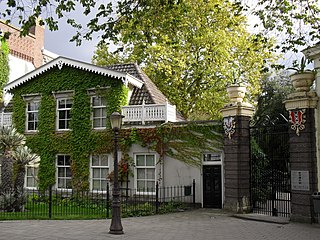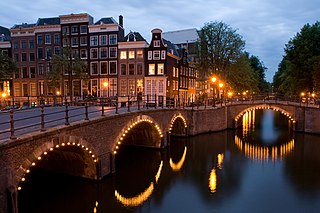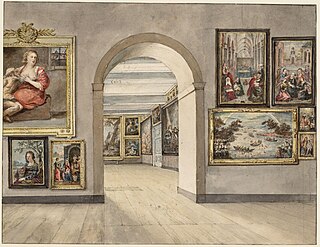History
The Prinsengracht, the third of the three main canals in the Amsterdam canal belt, was built in 1612. The part between the Leidsegracht and the Amstel belongs to the expansion of 1658. The part to the east of the Amstel was constructed with the last extension. This last part, the Nieuwe Prinsengracht, also called the Joodse Prinsengracht, was located in the prosperous part of Amsterdam's Jewish quarter, as were the Nieuwe Herengracht and the Nieuwe Keizersgracht.
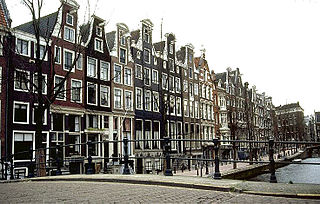
The Leidsegracht is a canal in Amsterdam, the Netherlands. It is a cross-canal in Amsterdam-Center hat connects Herengracht, Keizersgracht, Prinsengracht and Lijnbaansgracht and flows into the Singelgracht at Marnixstraat.
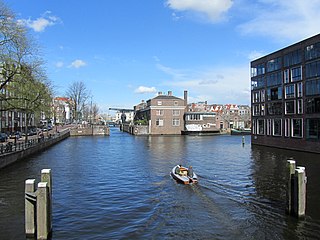
The Nieuwe Herengracht is a canal in Centrum district of Amsterdam. The canal is an extension of the Herengracht that runs between the Amstel and the Scharrebiersluis (lock) leading to the Schippersgracht from the Entrepotdok. It is in the Plantage neighborhood in the eastern part of the Grachtengordel.

The Nieuwe Keizersgracht is a canal in Amsterdam, part of the eastern Grachtengordel.
Until 1866 the Nieuwe Prinsengracht ran east of the Muidergracht to the Entrepotdok. The three ponds within the Artis zoo site still remain from the filled-in section of the canal.

The Entrepotdok, formerly Nieuwe Rapenburgergracht, is a canal in Amsterdam, and a street and row of former warehouses with the same name along the northeast side of the canal, now converted to apartments. It runs between the Kadijksplein and Sarphatistraat, and is parallel to Hoogte Kadijk, Laagte Kadijk, Plantage Doklaan and Natura Artis Magistra zoo. It is the largest inhabited warehouse complex in Amsterdam.

Artis, short for Natura Artis Magistra, is a zoo in the centre of Amsterdam. It is the oldest zoo in the Netherlands and one of the oldest zoos of mainland Europe. Next to possessing a zoo, Artis also contains an aquarium and a planetarium. Artis also has an arboretum and a fairly large art collection. A part of the art collection is on display in the Aquarium building of the zoo. Artis contains 27 monumental buildings, most of which are used as enclosures for the animals, making Artis a unique cultural heritage of the 19th century.
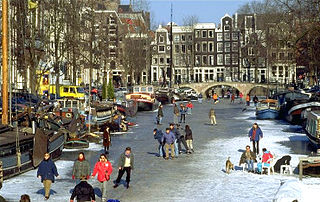
The Keizersgracht is a canal in Amsterdam, the Netherlands. It is the second of the three main Amsterdam canals that together form the Grachtengordel, or canal belt, and lies between the inner Herengracht and outer Prinsengracht.

Amsterdam, capital of the Netherlands, has more than one hundred kilometers of grachten (canals), about 90 islands and 1,500 bridges. The three main canals, dug in the 17th century during the Dutch Golden Age, form concentric belts around the city, known as the Grachtengordel. Alongside the main canals are 1550 monumental buildings. The 17th-century canal ring area, including the Prinsengracht, Keizersgracht, Herengracht and Jordaan, were listed as UNESCO World Heritage Site in 2010, contributing to Amsterdam's fame as the "Venice of the North".

The Grachtengordel is a neighborhood in Amsterdam, Netherlands located in the Centrum district. The seventeenth-century canals of Amsterdam, located in the center of Amsterdam, were added to the UNESCO World Heritage List in August 2010. The Amsterdam Canal District consists of the area around the city’s four main canals: the Singel, the Herengracht, the Keizersgracht, and the Prinsengracht. From the Brouwersgracht, the canals are generally parallel with one another, leading gradually southeast into the Amstel river.
The Kadijken, also known as Kadijkseiland or Kadijkenbuurt, is a neighbourhood to the north of Artis zoo in the centre of Amsterdam. The name "Kadijken" is the plural form of Kadijk and refers to the two main streets that traverse the neighbourhood, Hoogte Kadijk and Laagte Kadijk.
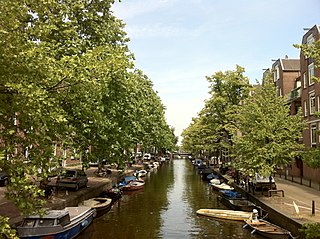
Lijnbaansgracht is a partly filled-in canal in Amsterdam which bends beyond the boundary of the center, Amsterdam-Centrum. The canal runs parallel to the Singelgracht, between the Brouwersgracht and the Reguliersgracht.

The Sarphatistraat is a street in the center of Amsterdam between Frederiksplein and Oostenburgergracht at the Cruquiuskade. The street crosses the Amstel and forms an almost 2 kilometres (1.2 mi) long connection between the southern part of the Grachtengordel and the Oostelijke Eilanden.

The Grimburgwal is a small canal and street in the center of Amsterdam.

The Nieuwe Vaart or Nieuwevaart is a 17th-century canal in Amsterdam that runs from the center to Amsterdam-Oost.

The Looiersgracht is a short canal in Amsterdam, between Prinsengracht and Lijnbaansgracht in the Jordaan neighborhood of the Amsterdam-Centrum district. The Looiersgracht borders the Grachtengordel. The Oude Looiersstraat runs parallel to the canal, and the Eerste, Tweede and Derde Looiersdwarsstraat are side streets entering the north side.

The Oudeschans, or Oude Schans, originally the Nieuwe Gracht, is a wide canal in the eastern part of the inner city of Amsterdam.
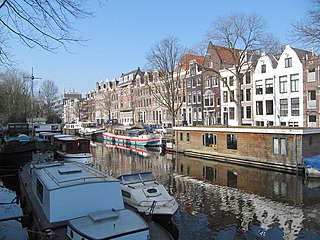
The Achtergracht is a short canal in Amsterdam, located between Frederiksplein and the Amstel, parallel to the Prinsengracht. The Achtergracht is located in the eastern part of the Grachtengordel.
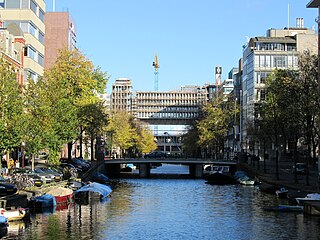
The Nieuwe Achtergracht is a canal in Amsterdam in the east of the [[Grachtengordel] in the Amsterdam-Centrum district. It runs parallel to the Nieuwe Prinsengracht and connects the Onbekendegracht with the Plantage Muidergracht. The canal is crossed by Weesperstraat and Roetersstraat.
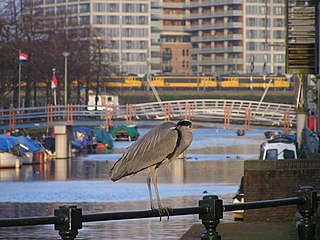
The Kattenburgervaart is a short canal in Amsterdam that runs through the Oostelijke Eilanden. The canal separates the island of Wittenburg, which was built in the 17th century, from the island of Kattenburg. The Kattenburgervaart runs parallel to the Wittenburgervaart from the Nieuwe Vaart to the Dijksgracht.
This page is based on this
Wikipedia article Text is available under the
CC BY-SA 4.0 license; additional terms may apply.
Images, videos and audio are available under their respective licenses.


